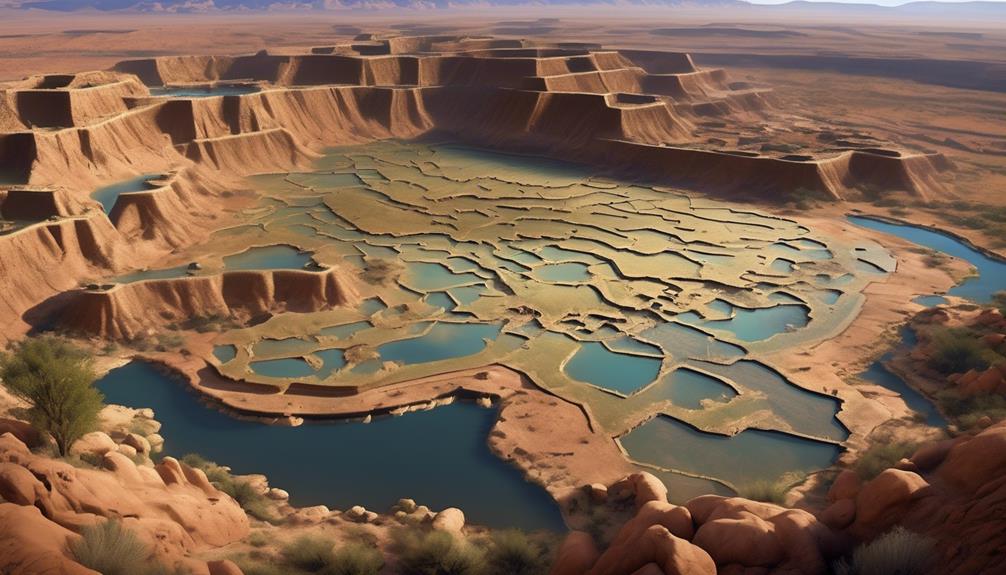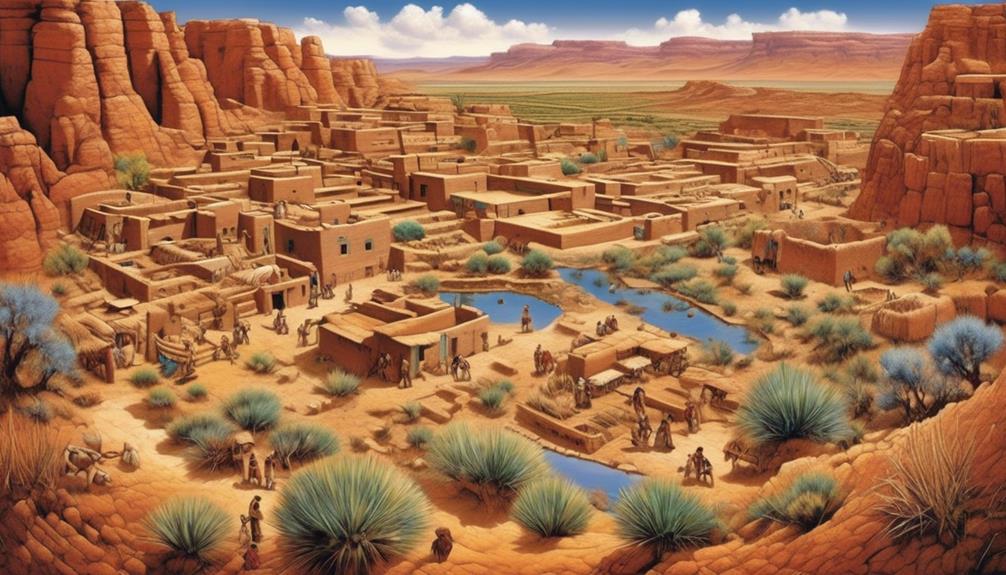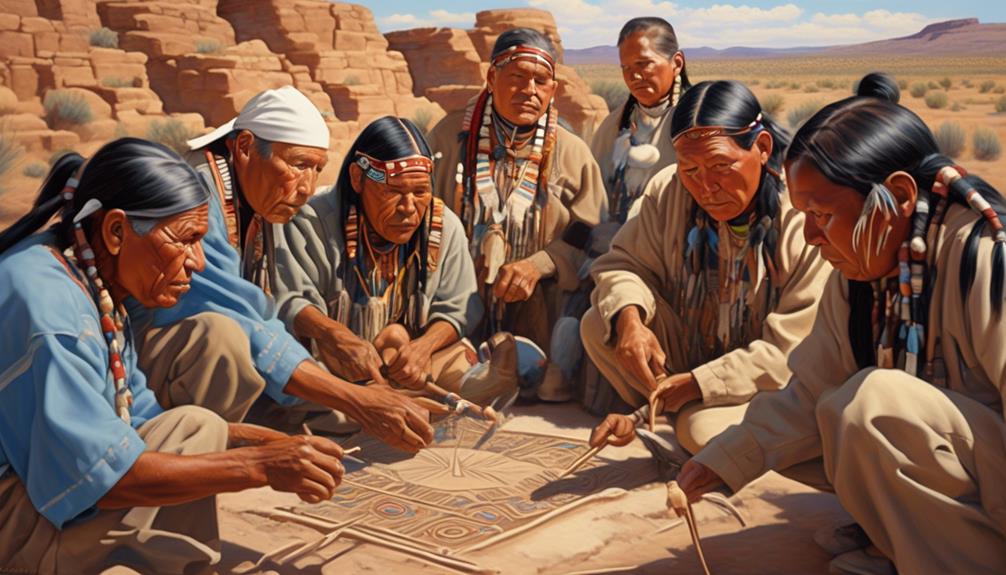Is there any truth to the idea that the environment played a crucial role in influencing the lifestyle of the Hopi tribe, a concept familiar to many of us?
As we explore the geographic location and topography of the Hopi lands, along with the annual precipitation, temperature variability, and seasonal climate patterns, we begin to uncover the intricate relationship between the Hopi people and their natural environment.
What we find may surprise you, shedding light on the ways in which climate influenced not just their daily lives, but also their cultural practices and traditions.
Key Takeaways
- The Hopi Tribe resides in northeastern Arizona on a high plateau with rugged terrain and unique geological formations.
- The average elevation of 6,500 feet impacts temperature, precipitation, and overall climate in the region.
- The arid environment and rocky terrain contribute to well-drained, sandy soil, which affects water retention and vegetation growth.
- The Hopi Tribe relies on various water sources for agriculture and daily needs, including historical use of catchment basins and stone dams to collect and store rainwater, as well as integration of modern technologies for water sustainability.
Geographic Location and Topography
In the northeastern region of Arizona, the Hopi Tribe resides on a high plateau characterized by rugged terrain and unique geological formations. The elevation impact on the local climate is substantial, as the plateau sits at an average elevation of 6,500 feet. This high elevation influences the temperature, precipitation, and overall climate experienced by the tribe.
The soil composition also plays a crucial role in the local climate. The arid environment and rocky terrain contribute to the development of a well-drained, sandy soil that's characteristic of the area. This soil type affects water retention and the types of vegetation that can thrive in the region, further impacting the local climate.
Understanding the geographic location and topography of the Hopi Tribe's homeland is essential for comprehending the nuances of their local climate. The high elevation and unique soil composition interact to create a climate that presents both challenges and opportunities for the tribe's agricultural practices and overall way of life. By studying these factors, we gain a deeper appreciation for the intricate relationship between geography and climate in shaping the experiences of the Hopi Tribe.
Annual Precipitation and Water Sources

Annually, the Hopi Tribe relies on a variety of water sources to sustain their agricultural practices and meet their daily needs.
Precipitation patterns play a crucial role in determining the success of our farming and availability of drinking water. The Hopi reservation experiences an arid climate with low average annual precipitation. However, we've historically managed to adapt to this through the utilization of reservoirs and other water conservation techniques.
Our ancestors constructed a sophisticated system of catchment basins and stone dams to collect and store rainwater, which continues to be a vital part of our water management strategy today. Additionally, we've integrated modern technologies to enhance our water sustainability, such as implementing irrigation systems and exploring alternative water sources like desalination and water recycling.
Despite the challenges posed by the arid climate, the Hopi Tribe remains committed to preserving our traditional agricultural practices and ensuring the availability of water for future generations.
Temperature Variability and Extremes
Experiencing temperature variability and extremes, we actively monitor weather patterns to adapt our agricultural practices and ensure the well-being of our community. Understanding temperature trends is crucial for our climate adaptation strategies.
Over the years, we've observed a noticeable increase in temperature variability, with more frequent and intense heatwaves. This has significant implications for our agricultural calendar and water management. Warmer temperatures affect crop growth and water availability, requiring us to adjust planting times and irrigation schedules.
Additionally, extreme heat poses health risks to our community, especially the elderly and young children. To mitigate these challenges, we've implemented various measures such as improving irrigation efficiency, diversifying crops, and promoting drought-resistant varieties.
Moreover, we're exploring traditional ecological knowledge combined with modern climate science to enhance our resilience to temperature extremes. By integrating our ancestral wisdom with contemporary understanding of temperature variability, we strive to safeguard our agricultural heritage and the well-being of our people.
Seasonal Climate Patterns and Agricultural Practices

Monitoring and understanding seasonal climate patterns is essential for our agricultural practices and the well-being of our community. Our traditional agricultural techniques have been finely tuned to the unique seasonal climate patterns that characterize our region.
The Hopi Tribe has long relied on the practice of crop rotation to ensure soil fertility and sustainable crop yields. By rotating different crops through the fields each year, we can maintain soil health and reduce the risk of depleting essential nutrients.
Additionally, we closely monitor seasonal climate patterns to determine the optimal timing for planting, irrigation, and harvest. For example, the onset and duration of the monsoon season greatly influence our planting decisions, as this precipitation is critical for our crops during the summer months.
Climate's Influence on Hopi Culture and Traditions
Our cultural practices and traditions are deeply intertwined with the climate of our region, shaping our way of life and connecting us to the land. The influence of our local climate on our culture is profound, leading to adaptation and the development of traditions that hold great cultural significance for the Hopi Tribe.
- Agricultural Sustainability: The arid climate of our region has influenced our agricultural practices, leading to the development of sustainable farming techniques such as dry farming and the use of drought-resistant crops like corn, beans, and squash.
- Adaptation: Our cultural traditions, including ceremonial dances and rituals, have evolved in response to the seasonal changes and climatic conditions. These adaptations demonstrate our deep connection to the land and the natural world.
- Cultural Significance: The climate's influence on our culture is reflected in our folklore, art, and oral traditions, which depict our reverence for the environment and the importance of living in harmony with nature.
Frequently Asked Questions
How Did the Hopi Tribe Adapt to Climate Change Over Time?
We adapted to climate change over time by developing various strategies. Environmental changes prompted us to innovate irrigation systems, adjust planting schedules, and diversify crops.
We also built homes with thick walls to regulate temperature and harvested rainwater. These adaptations allowed us to thrive in our arid environment, showcasing our ability to creatively respond to the challenges of climate change.
What Traditional Knowledge or Practices Do the Hopi People Use to Predict Weather Patterns?
Using traditional practices and indigenous knowledge, the Hopi people have honed their weather prediction techniques for generations. By observing nature's signs and interpreting celestial patterns, we adapt to climate changes.
Our ancient wisdom, passed down through storytelling and ritual, equips us to anticipate weather patterns and make necessary adjustments. This traditional knowledge is a testament to our resilience and deep connection to our environment, ensuring our ability to thrive amidst changing climates.
How Has the Local Climate Affected the Availability of Natural Resources for the Hopi Tribe?
The local climate has had a significant impact on the availability of natural resources for the Hopi tribe.
Through our traditional knowledge and adaptation practices, we've learned to predict and respond to the changing climate patterns.
The scarcity or abundance of water, plants, and animals directly affects our livelihood and cultural practices.
Our ability to adapt and utilize traditional knowledge has been crucial in navigating the challenges posed by the local climate.
What Role Does the Local Climate Play in the Spiritual and Religious Beliefs of the Hopi People?
The local climate plays a central role in the spiritual and religious beliefs of the Hopi people. The seasonal changes and natural phenomena are deeply intertwined with our spiritual practices and ceremonies.
The climate influences our agricultural cycles and impacts our connection to the land. Understanding the climate's rhythms is crucial for maintaining harmony with nature, as it directly shapes our religious rituals and spiritual connection to the earth.
Are There Any Specific Climate-Related Challenges or Threats That the Hopi Tribe Currently Faces?
Climate related challenges and environmental sustainability are pressing concerns for the Hopi tribe. Traditional agriculture is threatened due to water scarcity and unpredictable weather patterns.
Our community is actively seeking solutions to mitigate these challenges and preserve our cultural practices. We're exploring innovative methods to adapt to changing climates while maintaining our connection to the land.
Our commitment to environmental stewardship is essential for the future wellbeing of our tribe.
Conclusion
In conclusion, the local climate for the Hopi tribe plays a crucial role in shaping their culture and traditions.
For example, the seasonal climate patterns heavily influence their agricultural practices, as they rely on specific weather conditions for successful crop cultivation.
The climate also dictates the availability of water sources, impacting the tribe's daily life and ceremonial practices.
Overall, the local climate is deeply intertwined with the Hopi way of life.
Mary is a passionate writer who brings creativity and a fresh perspective to our team. Her words have the power to captivate and inspire, making her an essential contributor to our content. Mary’s commitment to storytelling and dedication to promoting Indigenous culture ensures that her work touches the hearts of our readers. We’re fortunate to have her as part of our team.










